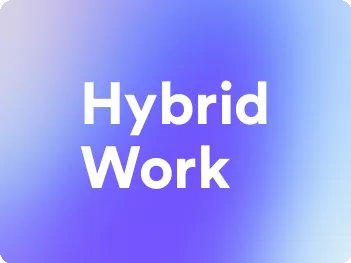Hybrid Work: Adapting to the New Normal
This guide will walk you through the essential elements of using hybrid work - the productivity method to keep your team productive and engaged.
Try Lark for Free
In recent times, the concept of hybrid work has gained substantial traction, shaping the way individuals and organizations approach workplace productivity. This article delves into the dynamics of hybrid work, its advantages, potential drawbacks, and actionable steps for effectively embracing this innovative work model.
Understanding Hybrid Work in the Context of Productivity
Hybrid work is a modern work arrangement that integrates both in-person office time and remote work. It represents a significant departure from the traditional 9-to-5 office routine and offers a flexible and adaptable approach to fostering productivity. At its core, hybrid work revolves around empowering employees to operate from diverse locations while maintaining seamless work processes. Embracing this model requires a comprehensive understanding of its impact on productivity, collaboration, and the overall work environment.
Exploring the Origin of Hybrid Work
The genesis of hybrid work can be traced to the intersection of technological advancements and evolving workplace preferences. The widespread adoption of digital communication tools, cloud-based technologies, and virtual collaboration platforms has facilitated a seamless transition to hybrid work. Additionally, the shift in employee expectations towards a better work-life balance has driven the need for flexible work arrangements, leading to the emergence of hybrid work as a viable solution.
Use Lark to unleash your team productivity.
Identifying the Target Audience for Hybrid Work
The concept of hybrid work resonates with a diverse spectrum of professionals, ranging from individual contributors to top-level executives. It caters to the needs of employees seeking a more balanced work environment, as well as employers aiming to optimize operational efficiency. Understanding the distinct requirements and preferences of various stakeholders is paramount in effectively implementing and sustaining a successful hybrid work model.
Evaluating the Pros and Cons of Hybrid Work
Pros of Hybrid Work
- Enhanced Flexibility: Empowering employees to work from diverse locations fosters a sense of autonomy and flexibility, which can lead to heightened job satisfaction and work-life balance.
- Cost Savings: Embracing hybrid work can result in reduced operational costs for employers, stemming from decreased office space requirements and associated overhead expenses.
- Expanded Talent Pool: By embracing remote work, organizations can tap into a broader talent pool, transcending geographical limitations and accessing a diverse array of skills and expertise.
Cons of Hybrid Work
- Communication Challenges: Balancing in-person and remote communication can pose hurdles, potentially leading to misalignment and reduced collaboration among team members.
- Operational Complexity: Managing a hybrid work environment necessitates robust infrastructure and strategic planning to ensure seamless integration and consistent productivity.
- Work-Life Boundary Blurring: For some individuals, the border between professional and personal life may become blurred, requiring proactive measures to maintain a healthy balance.
Learn more about Lark x Productivity
Navigating the Transition to Hybrid Work
Successfully embarking on the journey towards hybrid work necessitates a strategic and structured approach. To facilitate a smooth transition, organizations and individuals can consider the following steps.
Step-by-Step Guide for Embracing Hybrid Work
- Assessing Organizational Readiness: Conduct a comprehensive evaluation of the organization's technological capabilities, communication infrastructure, and overall readiness for adopting a hybrid work model.
- Defining Clear Policies and Guidelines: Establish transparent and well-defined policies governing remote work, in-office hours, communication protocols, and performance expectations to ensure clarity and consistency.
- Investing in Technological Enablement: Leverage advanced digital tools and collaboration platforms to facilitate seamless communication, project management, and virtual collaboration.
- Encouraging Open Dialogue: Foster an environment of open communication, actively addressing concerns and soliciting feedback from employees to adapt and refine the hybrid work strategy.
Use Lark to unleash your team productivity.
Actionable Tips for Maximizing Hybrid Work Productivity
One of the key aspects of hybrid work is to leverage strategies and best practices that optimize productivity while embracing flexibility.
- Embrace Agile Working Strategies: Implement agile methodologies and adaptive planning to facilitate productive workflows, especially in a distributed work environment.
- Establish Boundaries and Routines: Encourage employees to define clear boundaries between work and personal time, fostering a structured routine that ensures optimal productivity without sacrificing personal well-being.
Do's and Dont's of Hybrid Work
| Do's | Dont's |
|---|---|
| Establish clear communication protocols | Overlook the need for regular team check-ins |
| Encourage a culture of accountability | Neglect the mental well-being of remote employees |
| Foster an inclusive and collaborative ethos | Disregard the importance of periodic in-person interactions |
Embracing the Hybrid Future
As contemporary work dynamics continue to evolve, embracing the hybrid work model represents a strategic and forward-thinking approach to harnessing the potential of a diverse and technologically-enabled workforce. By understanding the intricacies of hybrid work, recognizing the unique requirements of stakeholders, and implementing robust frameworks, organizations and individuals can seamlessly adapt to this innovative work paradigm. Navigating this journey entails a commitment to flexibility, effective communication, and an unwavering focus on optimizing productivity.
